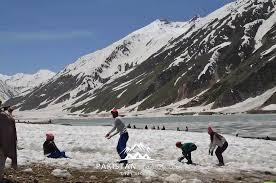“Saiful Muluk & Beyond: Exploring Naran Kaghan Valley”

Nestled in the mighty Himalayas of northern Pakistan, the Naran Kaghan Valley is a land of legends, pristine lakes, alpine meadows, and snow-capped peaks that attract travelers from across the country and beyond. Among its many treasures, Lake Saiful Muluk stands out as the crown jewel—a place wrapped in myths and natural splendor. But the valley is much more than a single destination. From hidden alpine lakes to panoramic mountain passes, Naran Kaghan offers an endless journey for nature lovers, adventurers, and dreamers alike.
In this article, we’ll take you from Saiful Muluk and its folklore to the lesser-known wonders that make the valley one of Pakistan’s most enchanting travel experiences.
The Legend of Saiful Muluk
At an elevation of 10,578 feet, Lake Saiful Muluk lies surrounded by towering peaks, the most striking of which is Malika Parbat, the “Queen of Mountains.” The lake is renowned not only for its breathtaking beauty but also for the fairy tale of Prince Saiful Muluk and the fairy princess Badi-ul-Jamal, a story that locals still recount with pride.
According to legend, the lake was a meeting place between the prince and the fairy princess, and to this day, many believe that fairies descend on moonlit nights to dance upon its waters. This blend of mythology and nature makes Saiful Muluk more than just a tourist attraction—it is a place where imagination meets reality.
Reaching Saiful Muluk
The journey to Saiful Muluk begins from Naran town, a bustling base camp for travelers. From here, a rugged jeep track winds up to the lake, passing through rocky slopes and glacier-fed streams. Though the ride can be bumpy, the scenery is worth every moment.
Upon arrival, the emerald-green waters of the lake reflect the surrounding peaks like a giant mirror. In summer, visitors can take a wooden boat ride across its surface or simply sit along the shore, breathing in the crisp mountain air. In winter, however, the lake freezes into a sheet of ice, transforming into an otherworldly spectacle.
Beyond Saiful Muluk: Dudipatsar Lake
While Saiful Muluk is the most famous lake, the valley has many more secrets to offer. Among them is Dudipatsar Lake, often called the “Queen of Lakes.” Situated at 12,500 feet, this alpine wonder is reached after a challenging trek through wildflower meadows, grazing pastures, and glacial streams.
Dudipatsar’s turquoise waters are surrounded by snow-clad peaks that remain frozen even in mid-summer, creating a dramatic contrast with the lake’s calm surface. For trekkers and adventurers, reaching this hidden gem is an unforgettable experience that defines the very spirit of exploration.
Lulusar Lake: The Source of the Kunhar River
On the road to Babusar Top lies another highlight—Lulusar Lake, a vast body of water at 11,200 feet. It is not only strikingly beautiful but also historically significant, as it marks the birthplace of the Kunhar River.
Lulusar is less crowded than Saiful Muluk, making it a peaceful stop where travelers can enjoy the silence of the mountains. The lake is also an excellent spot for photography, with its glassy surface mirroring the snow-covered ridges above.
Babusar Top: Gateway to the North
No journey through Naran Kaghan is complete without visiting Babusar Top, the highest point of the valley at 13,700 feet. This mountain pass connects Kaghan Valley to Gilgit-Baltistan and offers jaw-dropping views of the surrounding ranges.
From Babusar, travelers can see distant peaks of the Karakoram and Hindu Kush ranges, while colorful prayer flags flutter in the chilly winds. The road leading to the pass is an adventure in itself, with sharp curves, rolling meadows, and glimpses of wildlife like marmots and ibex.
Meadows and Villages
Beyond its lakes and peaks, the charm of Naran Kaghan also lies in its alpine meadows and small villages. Places like Besal and Shogran showcase the pastoral beauty of the region, with wooden huts, grazing yaks, and shepherds guiding their flocks through flower-filled fields.
In Shogran, the Siri Paye meadows are particularly famous for their panoramic views. On a clear day, the majestic Makra Peak towers in the background, while the meadows themselves burst into bloom with wildflowers during the summer months.
Adventure Awaits
For those seeking adventure, Naran Kaghan is a playground. From jeep safaris and hiking trails to camping under starlit skies, the valley offers experiences that suit all kinds of travelers.
-
Hiking & Trekking: Trails to Dudipatsar, Ansoo Lake, and Lalazar Meadows challenge trekkers with rewarding scenery.
-
Camping: Besal and Saiful Muluk are popular camping sites where nights are filled with the sound of rushing streams and skies studded with stars.
-
Photography: Every bend in the valley reveals postcard-worthy views, from rivers cascading through gorges to alpine lakes glowing in the sunlight.
Local Culture and Hospitality
The people of Naran Kaghan add warmth to the valley’s charm. The Gujjar and Kohistani communities are known for their simplicity and hospitality. Small roadside tea stalls and trout fish restaurants offer a taste of the region’s local flavor.
Storytelling is a cherished tradition here, with locals narrating folk tales of fairies, hidden treasures, and ancient travelers who once crossed these mountains. For many visitors, these cultural exchanges leave as lasting an impression as the scenery itself.
When to Visit
The best time to explore Saiful Muluk and beyond is between June and September, when the roads are open, and the weather is pleasant.
-
June–July: Snow melts, rivers and lakes swell, and meadows bloom.
-
August: Peak tourist season, lively atmosphere.
-
September: Cooler weather, autumn hues, and fewer crowds—perfect for a peaceful journey.
Winters in Naran Kaghan are harsh, with heavy snowfall cutting off access to many parts of the valley, including Babusar Top and Saiful Muluk.
Suggested Itinerary
For those planning a trip, here’s a simple 4-day itinerary to explore the highlights:
-
Day 1: Drive from Islamabad to Naran via Balakot and Kaghan. Overnight stay in Naran.
-
Day 2: Jeep ride to Lake Saiful Muluk, explore, and return to Naran.
-
Day 3: Visit Lulusar Lake, Besal, and Babusar Top. Overnight in Naran.
-
Day 4: Depart Naran, with optional stops at Shogran and Siri Paye Meadows.
For trekkers, an extended 5–7 day trip allows time to reach Dudipatsar or Ansoo Lake.
Conclusion
The story of Naran Kaghan cannot be told with just one place, not even with the legendary Lake Saiful Muluk. The valley is a living masterpiece, where every bend of the road, every meadow, and every lake tells its own story. From the myth-filled waters of Saiful Muluk to the quiet beauty of Dudipatsar, the road to Babusar, and the meadows of Shogran, this valley invites you to go beyond and discover more.







